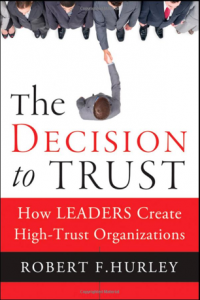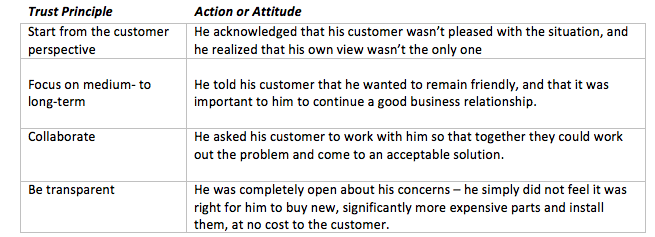Story Time: How One Conversation Changed Everything
Our Story Time series brings you real, personal examples from business life that shed light on specific ways to lead with trust. Our last story told a tale of risky business. Today’s anecdote zeroes in on the importance of being willing to interrupt the status quo.
A New Anthology
When it comes to trust-building, stories are a powerful tool for both learning and change. Our new book, The Trusted Advisor Fieldbook: A Comprehensive Toolkit for Leading with Trust (Wiley, October 2011), contains a multitude of stories. Told by and about people we know, these stories illustrate the fundamental attitudes, truths, and principles of trustworthiness.
Today’s story is excerpted from our chapter on shifting from tactics to strategy. It demonstrates how simple it can be to dramatically alter the nature of a working relationship, and pave the way for delivering far greater value.
From the Front Lines: Upping the Ante
Sarah Agan tells us about the conversation that changed everything with her client, John.
“I had just joined a new consulting firm and was asked to take over as the engagement manager for a project that I soon learned was in dire straits. My client John was happy—he was responsible for a high-priority government-wide initiative with the potential to catapult his career, he had a high-end strategy firm by his side (that was us), and he was getting everything he thought he wanted—a well-documented plan identifying key investments required to guard against terrorist attacks.
“The problem was this: my team was very unhappy. Imagine a group of super-bright, creative, energized young graduates, well-trained in strategy development and execution, assigned to a high-visibility project, sitting in a windowless conference room formatting Excel spreadsheets. It was a troubled project that everyone in my firm had heard about and no one wanted to work on.
“While it was tempting to step in and make a dramatic move, I bided my time. I focused first on developing my relationship with John, understanding his interests and priorities. In several of our initial meetings he made reference to our team as his ‘administrative support.’ At first, I just filed it away. He was happy with the arrangement. He had no idea what he could or should expect from us.
“I also made a point to find out more about how our company had ended up in this predicament. We had fallen into the trap of being seduced by a lucrative long-term contract, doing whatever it took to keep the funding coming.
“One day when John referred to us again as his ‘administrative support,’ I decided it was time to speak up.
“I don’t recall being particularly nervous at the time. I just spoke from the heart: ‘John, this is at least the third time I’ve heard you refer to us as your administrative support. If that’s what you truly feel you need, let us help you find someone who does this as a core competency at a fraction of what you are paying us. If you’re interested in doing things more strategically, I’d love to have that conversation.’
“From that moment, everything shifted. The nature of all our conversations changed. The team began to bring ideas to the table, like helping John host a national workshop—with representatives from across the government, academia, and private industry—so that John could engage all his stakeholders in a way that they would have some ownership for the nationwide plan. It was an extraordinary workshop John’s successor is still talking about years later.
“Now we were positioned to deliver the kind of value we were truly capable of. The project that no one wanted to be on became a project people wanted to be part of.
“The biggest lesson for me in all of this was the importance of being willing to interrupt the status quo and say what had been left unsaid for too long in order to focus on what really mattered to John. Looking back, it was a pretty risky move. It was also the right one. Nothing ventured, nothing gained.”
—Sarah Agan
What’s been left unsaid for too long in one of your relationships?
++++++
Read more stories about trust:
- Risky business
- When to walk away
- An unexpected way to recover lost trust
- An unexpected approach to developing new business with trust
- Leading with trust in the C-suite
——————————————————————————————-
Many Trusted Advisor programs now offer CPE credits. Please call Tracey DelCamp for more information at 856-981-5268–or drop us a note @ [email protected].

 This is the eighth in a series called
This is the eighth in a series called 
 Sometimes I get annoyed. Usually, that means I’m thinking like an idiot. Sometimes, however, it produces useful ideas.
Sometimes I get annoyed. Usually, that means I’m thinking like an idiot. Sometimes, however, it produces useful ideas.